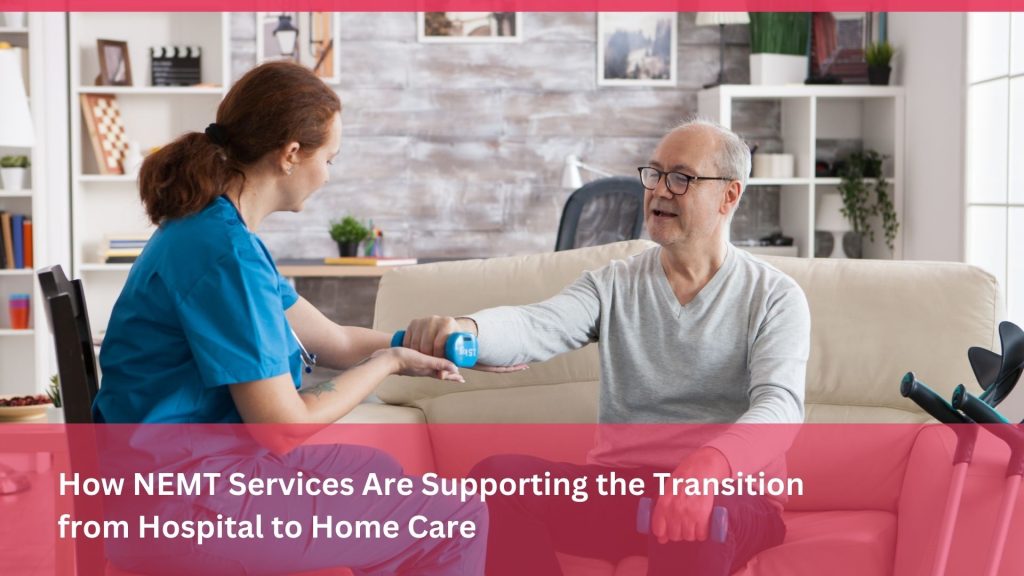New at Safr Care
How NEMT Services Are Supporting the Transition from Hospital to Home Care

How NEMT Services Are Supporting the Transition from Hospital to Home Care
The transition from hospital to home care is a critical phase in a patient’s recovery journey. For many individuals, especially those with chronic illnesses, disabilities, or age-related conditions, this transition can be fraught with challenges. One of the most significant barriers to a smooth transition is transportation. Non-Emergency Medical Transportation (NEMT) services have emerged as a vital solution to this problem, ensuring that patients can move safely and comfortably from hospital to home while receiving the care they need. This article explores how NEMT services are revolutionizing the post-hospitalization process, improving patient outcomes, and supporting the broader healthcare ecosystem.
The Importance of a Smooth Transition from Hospital to Home Care
The period following a hospital discharge is often a vulnerable time for patients. Studies have shown that poorly managed transitions can lead to complications, readmissions, and even increased mortality rates. According to the Agency for Healthcare Research and Quality (AHRQ), nearly 20% of patients experience adverse events within three weeks of discharge, many of which could have been prevented with better coordination and support.
A smooth transition from hospital to home care involves several key components: continuity of care, access to resources, and safe transportation. NEMT services address the transportation aspect of this transition, playing a pivotal role in bridging the gap between hospital and home care.
What Are NEMT Services?
Non-Emergency Medical Transportation (NEMT) refers to transportation services designed for individuals who do not require emergency medical attention but need assistance to travel to and from medical appointments, rehabilitation centers, or their homes. These services are particularly beneficial for elderly patients, individuals with disabilities, patients recovering from surgery or illness, and those with chronic conditions requiring frequent medical visits.
How NEMT Services Support the Transition from Hospital to Home Care
- Ensuring Safe and Reliable Transportation: NEMT services provide safe and reliable transportation for patients recovering from surgery or managing chronic conditions.
- Reducing Hospital Readmissions: By ensuring patients attend follow-up appointments, NEMT services help reduce readmissions.
- Enhancing Patient Independence and Quality of Life: NEMT services empower patients to attend medical appointments and engage in social activities.
- Supporting Caregivers and Families: NEMT services alleviate the burden on caregivers by handling transportation responsibilities.
- Facilitating Access to Specialized Care: NEMT services enable patients to travel to distant medical facilities for specialized care.
- Improving Health Equity: NEMT services ensure that all patients, regardless of socioeconomic status, have access to care.
The Role of Technology in NEMT Services
Technology has played a significant role in enhancing the efficiency and effectiveness of NEMT services. Many NEMT providers now use advanced software solutions to streamline operations, improve communication, and enhance the patient experience.
Challenges and Opportunities in the NEMT Industry
While NEMT services have made significant strides, the industry still faces challenges such as funding and reimbursement issues, workforce shortages, regulatory compliance, and technological barriers. However, these challenges also present opportunities for growth and innovation.
The Future of NEMT Services
The future of NEMT services is bright, with trends such as the expansion of on-demand services, integration with healthcare ecosystems, a focus on patient-centered care, and the adoption of sustainable practices shaping the industry.
Conclusion
NEMT services are playing a crucial role in supporting the transition from hospital to home care, addressing transportation barriers, and improving patient outcomes. As the healthcare landscape continues to evolve, NEMT services will remain an essential component of the care continuum, ensuring that all patients have the support they need to thrive.
